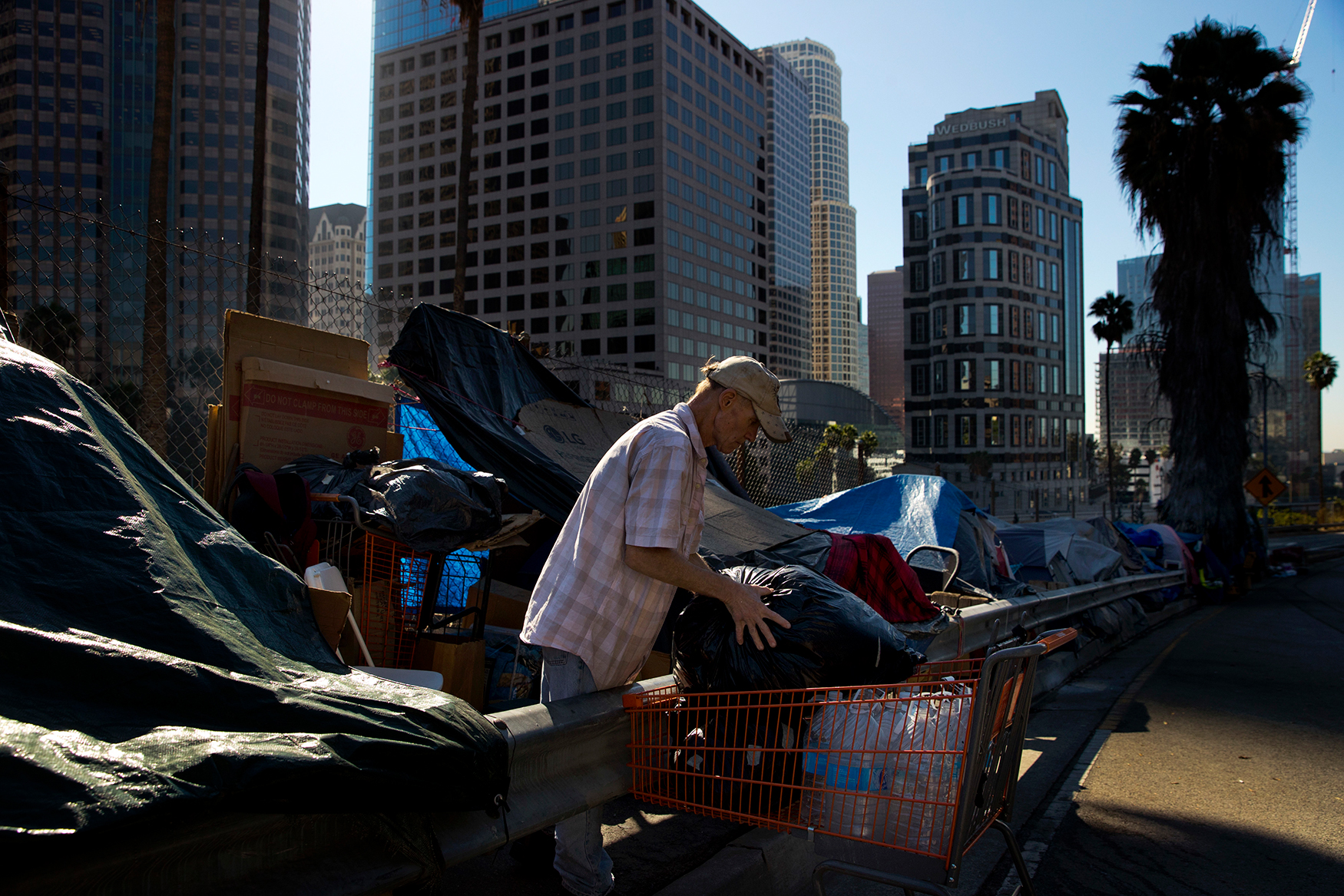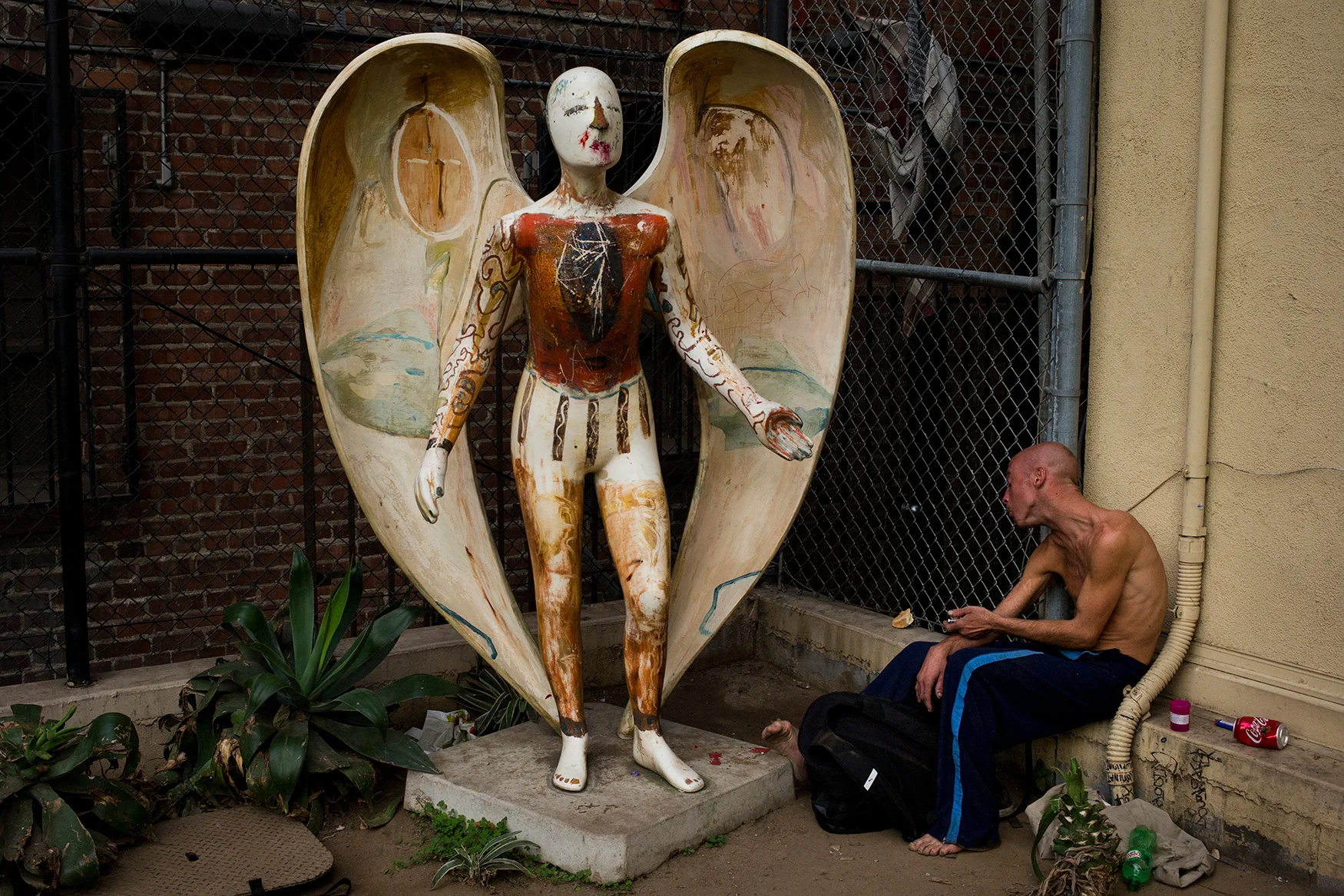AP photographer shares experience documenting homelessness

I was drawn to document life on Skid Row after being repulsed by it.
Initially, it wasn’t to bring awareness to the plight of the people there or to give voice to the homeless. It was more of a visual curiosity.
Tents were dwarfed by multimillion-dollar buildings. People were shooting heroin and smoking crack in broad daylight. A mentally-ill woman was screaming and cursing as if seeing a ghost.
My first encounter with this square mile of misery nearly a decade ago remains a vivid memory. I passed through in my car and double-checked to make sure my doors were locked and windows rolled up tight. It wasn’t fear; it was shock.
When I returned a couple years later, I was on foot with my camera. I had to experience, the sights, sounds and smells up close.
The project to document the homeless crisis on the West Coast began in late August. Except for a few days covering Northern California wildfires and the World Series, this is all I did for nearly three months.
A large homeless encampment is formed on the "Plaza of the Flags" elevated park at the Santa Ana Civic Center complex Wednesday, Oct. 11, 2017, in Santa Ana, Calif. California declared a statewide emergency due to a hepatitis A outbreak linked to homeless encampments. Comparisons are being made to conditions more commonly seen in Third World countries. (AP Photo/Jae C. Hong)
I walked a lot and talked to a lot of people. Many generously told me their stories. Some were clearly high or crazy. Others were scary.
People cursed me inches from my face, spittle flying from their mouths. A woman living on Skid Row warned me that no one would kill me on Skid Row because they didn’t want trouble with the police, but they might rough me up.
I saw so much of people in their rawest moments that I couldn’t bring myself to take photos of some of it.
A homeless man takes food from a trash can in Los Angeles' Skid Row area, home to the nation's largest concentration of homeless people, Saturday, Oct. 28, 2017, in Los Angeles. At least 10 cities have declared official states of emergency, and California declared a statewide emergency due to a hepatitis A outbreak linked to homeless encampments. Comparisons are being made to conditions more commonly seen in Third World countries. (AP Photo/Jae C. Hong)
I dialed 911 four times to get help for people. One was a drug addict passed out in the middle of a street intersection on Skid Row. Another was a naked woman in a tree in Santa Ana talking to herself in Spanish.
There’s always an internal struggle. As a photographer, I want to capture the moment because my job is to tell the story. As a human, the agony can be too hard to watch. Some don’t know they need help or that help exists.
I have sympathy for the poor. I don’t judge them now that I’ve seen so many people in dire situations from different circumstances and have heard about their lives. Many times I’ve tried to comfort them with encouraging words.
Covering herself with a blanket, homeless woman Christian McKenzie, a 29-year-old heroin addict and mother of a 7-year-old boy, settles down next to a wall in the Waterfront Park area in Seattle on Thursday, Sept. 28, 2017. "I'm doing drugs still, but I'm not doing them as much. I've restrained myself all day not to," said McKenzie. "I miss my kitchen. I miss my kid." (AP Photo/Jae C. Hong)
I wish I understood the problem of homelessness better than before. Truth is I’m more confused than ever. I can’t see a solution.
I made plenty of mistakes growing up. We all did. But my parents loved me and supported me. My mother even gave up her job as a school teacher in South Korea so my brother and I could study in the U.S. How many on Skid Row had that luxury?
I now live in a two-bedroom condo in a gated community. The refrigerator is full of food. There’s a hot shower and comfortable bed.
Two homeless people, Tammy Stephen, 54, left, and Bennie Koffa, 66, walk past each other at Camp Second Chance, a city-sanctioned homeless encampment, Tuesday, Sept. 26, 2017, in Seattle. Against the backdrop of its booming economy, the West Coast is experiencing another type of boom_a massive surge in homeless people living on the streets that in many places is beginning to overwhelm the ability of local governments to deal with it. (AP Photo/Jae C. Hong)
Skid Row is like a planet of its own. I’m just orbiting it as an observer.
One night this week, there were two long lines on the edge of downtown Los Angeles.
One was the usual line of homeless waiting for dinner at the Midnight Mission. The other, a few blocks from where drugs rule the street, was to get into Gwen Stefani’s meet-and-greet to celebrate her holiday album “You Make It Feel Like Christmas.”
My home will soon start to feel like Christmas as my wife starts decorating. There will even be Christmas on Skid Row, too.
Well-meaning folks and some celebrities and politicians will dish out meals. Blankets will be given as gifts. I hope they do more than just cover up all the suffering.
Lying on a urine-stained sidewalk, two homeless drug addicts, high on drugs, hallucinate in Los Angeles' Skid Row area, home to the nation's largest concentration of homeless people, Friday, Sept. 1, 2017. According to Midnight Mission's Joey Weinert, a former drug addict who now helps homeless people fight their addictions, said many homeless use drugs and alcohol to cope with their lives. (AP Photo/Jae C. Hong)
Wearing a "Make America Great Again" hat, Nathanael Baisley, 38, sits in a bus in Los Angeles en route to Santa Monica Beach, where he spends the night, Saturday, Oct. 28, 2017. Baisley said he has been homeless on and off for three years and is going through a divorce with his wife who lives in England with their 5-year-old son. (AP Photo/Jae C. Hong)
Sitting on a bed in a temporary shelter at Grace Baptist Church on Tuesday, Oct. 24, 2017, Bernadette Ortiz, a 39-year-old homeless woman, kisses her 9-day-old baby girl, Serenity, as her fiance and the baby's father, Ricardo Lopez, foreground, trims flowers they received as gifts after Ortiz gave a birth, in San Jose, Calif. The couple is moving into a studio apartment in a week, Ortiz's first home in five years. (AP Photo/Jae C. Hong)
Homeless people wait in line for a meal served by a community organization outside Our Lady Queen of Angels Catholic Church Thursday, Sept. 21, 2017, in Los Angeles. A homeless crisis of unprecedented proportions is rocking the West Coast, and its victims are being left behind by the very things that mark the region's success: soaring housing costs, rock-bottom vacancy rates and a roaring economy that waits for no one. (AP Photo/Jae C. Hong)
James Williams, 50, who has been on the street for 20 years, sits in a wheelchair in the tunnel where he spends the night Friday, Sept. 1, 2017, in downtown Los Angeles. Williams was dropped off by a taxi near the tunnel the night before, after being hospitalized for more than a week due to respiratory problems. He wanted to avoid a shelter because he said it would be too crowded. (AP Photo/Jae C. Hong)
Delmi Ruiz, 41, who is five months pregnant, works in the kitchen area of her RV parked in front of an apartment building, where the monthly rent for a one-bedroom unit is more than $3000, Monday, Oct. 23, 2017, in Mountain View, Calif. Ruiz and her husband, who works as a landscaper earning minimum wage, have been living in the RV for more than two years with their four children after they could no longer afford the rent. (AP Photo/Jae C. Hong)
A piece of bread is left on a sidewalk as Korey Epps, a 44-year-old homeless man who had his leg amputated due to an infection while in jail, waits in line to enter Seattle's Union Gospel Mission to spend the night at the shelter Wednesday, Sept. 27, 2017, in Seattle. Serving 14 months in jail, Epps said he lost his job, family and home. "Everyday I feel more more worthless, hopeless. I can't believe this is where my life is," said Epps. "I may as well be on drugs because I lost everything." (AP Photo/Jae C. Hong)
A homeless woman, who declined to give her name, eats chicken soup with a piece of bread while others wait in line for food Wednesday, Sept. 20, 2017, in downtown Los Angeles. According to the annual count released in May by the Los Angeles Homeless Services Authority, Los Angeles County's homeless population has increased to 57,794, a 23 percent jump from last year's count. (AP Photo/Jae C. Hong)
A man walks past a mural of angel wings titled "Africa Wings" by artist Colette Miller in Los Angeles' Skid Row area, home to the nation's largest concentration of homeless people, Friday, Sept. 1, 2017. According to the annual count released in May by the Los Angeles Homeless Services Authority, Los Angeles County's homeless population has increased to 57,794, a 23 percent jump from last year's count. (AP Photo/Jae C. Hong)
A mentally disabled woman stares at a camera as a homeless drug addict, who said his name was April Jane, sits on a sidewalk asking for money, Thursday, Nov. 2, 2017, in downtown Los Angeles. The latest nationwide homeless count shows that 4 of every 10 people living on the street are severely mentally ill or have a serious drug addiction. (AP Photo/Jae C. Hong)
Sitting in front of a tent pitched on a sidewalk, Daniel Shawn, a 48-year-old homeless man, is silhouetted against the street lights Wednesday, Sept. 6, 2017, in downtown Los Angeles. Since last fall, Los Angeles city and county voters approved spending $4.7 billion in an attempt to tackle the problem, largely through adding low-cost housing. (AP Photo/Jae C. Hong)
As part of its project looking at the homeless crisis on the West Coast, AP photographer Jae Hong went to Seattle, the San Francisco Bay Area and Los Angeles to shoot intimate portraits of the people with no permanent homes. He used a tilt and shift lens to focus on their eyes. 'Behind Their Eyes' portrait series
Text from the AP news story, AP photographer shares experience documenting homelessness, by Jae C. Hong.
See AP's coverage of the West Coast homeless crisis here.
Photos by Jae C. Hong
Visual artist and Journalist







